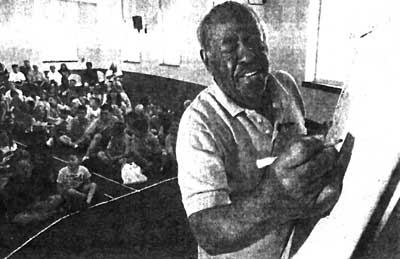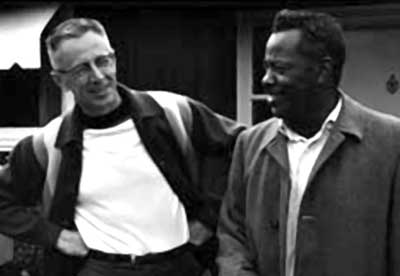|
 |
| Karol Trachtenberg exhibits a shirt designed by her "hubby" cartoonist Morrie Turner. Turner was a leader in opening the media to civil rights and women's rights. |
| |
 |
| Karol met Morrie while working as an event administrator at U. C. Sac State. Morrie was teaching a week-long summer program on cartooning for kids |
| |
 |
| At a comic strip convention, Morrie Turner asked "Peanuts" creator Charles Shultz why there were no minorities in comics. Shultz suggested that he create one. |
| |
| |
|
|
I've known Karol Trachtenberg for about three years, roughly a year after Adele and I moved to West Sacramento. She had often mentioned her "hubby" and I had seen his cartoons on her walls.
But it wasn't until this week that I was blown away to realize that "hubby" was Morrie Turner, a remarkably important figure in achieving civil rights in the U.S. following the death of Martin Luther King.
In the 1960s when the mainstream media was largely segregated, Morrie launched the first integrated comic strip, Wee Pals, and it grew to syndication in 100 newspapers. In doing so, he became the first nationally syndicated African-American comic artist—and his down to earth comic strip which featured a diversity of characters helped open its readers to the experience of an integrated society.
Morris Nolton Turner, creator of the first American syndicated strip with an integrated cast of characters, was born in Oakland, CA in 1923 and learned cartooning through a correspondence course.
During World War II, where he served as a mechanic with Tuskegee Airmen, his illustrations appeared in the newspaper Stars and Stripes. After the war, while working for the Oakland Police Department, he created the comic strip Baker's Helper. In 2000, the Cartoon Art Museum presented Turner with the Sparky Award, named in honor of Charles Schulz.
At a comic strip convention, he asked "Peanuts" creator Charles Shultz why there were no minorities in comics. Shultz suggested that he create one.
Morris' first attempt, Dinky Fellas, featured an all-black cast, but found publication in only one newspaper, the Chicago Defender. Turner integrated the strip, renaming it Wee Pals, and in 1965 it became the first American syndicated comic strip to have a cast of diverse ethnicity.
|
Although the strip was only originally carried by five newspapers, it was picked up by more than 100 after Civil Rights leader Martin Luther King's assassination in 1968.
Morrie appeared on Mister Rogers' Neighborhood. During the Vietnam War, Turner with five members of the National Cartoonist Society traveled to Vietnam, where they spent a month drawing more than 3,000 caricatures of service people.
Turner championed women's rights and jokingly addressed issues of unfairness in American society.
For a detailed retrospective, see the Washington Post article, RIP, MORRIE TURNER: Cartoonists say farewell to a friend, a hero, a 'Wee Pals' pioneer.
Karol met Morrie while working as an event administrator at U. C. Sac State. Morrie was teaching a week-long summer program on cartooning for kids.
By the end of the week, and although they were over 15 years apart—she at 45 and he at 60— they developed a friendship and began dating which developed into a loving relationship that lasted 30 years until Morrie's passing.
Toward his later years, Morrie had a variety of health problems, and one—a need for dialysis—required him to stay with Karol in West Sacramento.
"We lived together for 30 years," Karol explained, "I considered him a 'husband.' It was easier to say than—'boyfriend.' We were too old to bother with that kind to stuff."
"His art was fantastic," Karol continued. "He visited schools and did a lot of work with young children. To this day, I can't go anywhere, if anyone finds out I was with Morrie, they would say, 'Hey, he came to my class when I was in such and such a grade and he drew me.' They'd take it home and their parents would frame the picture and they kept it—he touched a lot of lives."
~ Al Zagofsky
|
